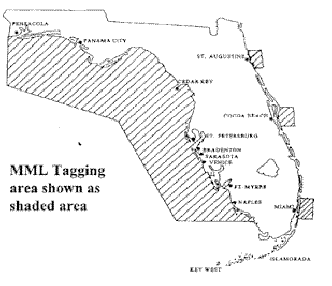The MML Reef Fish Tagging Program
This program is unique in that it has been supported at one time or another by all the sectors of the reef fish fishery. It was started in 1990 with funds from the commercial fishers of the Southwest Offshore
Fishing Association (SOFA). More recently the program has continued on donations from the Sarasota Sports Fishing Association and the Florida Sport Fishing Association and volunteers from the recreational sector. We have also had
considerable help from the charter and headboat industry.
 Since its inception in 1990, The Mote Marine Laboratory Reef Fish Tagging Project coverage has grown from sites off
Madeira Beach and Sarasota, Florida, to encompass most of the west coast of Florida and a few locations off the east coast.
Since its inception in 1990, The Mote Marine Laboratory Reef Fish Tagging Project coverage has grown from sites off
Madeira Beach and Sarasota, Florida, to encompass most of the west coast of Florida and a few locations off the east coast.
Data from this program is being disseminated in various ways. One way is through a
newsletter which is sent to all participating taggers, interested fishery scientists, fisheries managers and outdoor writers. The data have also been used by the National Marine Fisheries Service for stock assessment purposes.
These data have also have been and will be the basis of peer reviewed scientific journal publications. For more information, just call us on our toll free number, 1-800-388-3966
Return to top
|
Target Reef Fish Tagged/Returned |
|
10/1990 through 10/16/02 |
| Species |
Number Tagged |
Number Returned |
Return Rate |
| Black Grouper |
7 |
0 |
0% |
| Gag |
3668 |
378 |
10% |
| Giant Grouper |
2 |
0 |
0% |
| Lane Snapper |
14 |
1 |
7% |
| Mangrove Snapper |
771 |
20 |
3% |
| Mutton Snapper |
16 |
4 |
25% |
| Nassau Grouper |
2 |
1 |
50% |
| Red Grouper |
8321 |
856 |
10% |
| Red Hind |
2 |
0 |
0% |
| Red Snapper |
2820 |
150 |
5% |
| Rock Hind |
1 |
0 |
0% |
| Scamp |
260 |
25 |
10% |
| Speckled Hind |
14 |
1 |
7% |
| Vermilion Snapper |
618 |
2 |
0% |
We have found that the single barbed dart tags being used in this study are effective for reef fish when inserted properly. Always remember to insert the tag as close to the
dorsal fin as possible. The objective is to subcutaneously hook the barb on the spines. If this is accomplished, the tag will remain secure. We have had fish returned after 6 years of freedom. On the other hand , if the tag is
inserted into the muscle tissue, it will not remain in the fish and can be easily removed with a light tug.
Last Update:
October 22, 2002